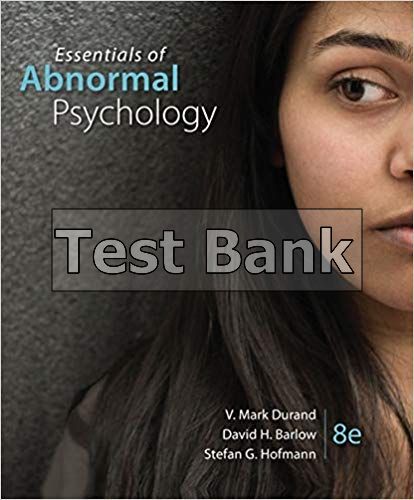Essentials of Abnormal Psychology 8th Edition Durand Test Bank
$55.00 Original price was: $55.00.$29.99Current price is: $29.99.
Essentials of Abnormal Psychology 8th Edition Durand Test Bank
Instant download Essentials of Abnormal Psychology 8th Edition Durand Test Bank pdf docx epub after payment.

Product details:
- ISBN-10 : 9781337619370
- ISBN-13 : 978-1337619370
- Author: V. Mark Durand; David H. Barlow; Stefan G. Hofmann
Through Durand, Barlow, and Hofmann’s Essentials of Abnormal Psychology, you’ll learn that psychological disorders are rarely caused by a single influence, but rooted in the interaction among multiple factors: biological, psychological, cultural, social, familial, and even political. A conversational writing style, consistent pedagogy, and real case profiles provide a realistic context for the scientific findings. These features show you the real people behind the DSM-5 criteria, the theories, and the research.
Table of contents:
- 1. ABNORMAL BEHAVIOR IN HISTORICAL CONTEXT
- Understanding Psychopathology
- What Is a Psychological Disorder?
- The Science of Psychopathology
- Historical Conceptions of Abnormal Behavior
- The Supernatural Tradition
- Demons and Witches
- Stress and Melancholy
- Treatments for Possession
- Mass Hysteria
- Modern Mass Hysteria
- The Moon and the Stars
- Comments
- The Biological Tradition
- Hippocrates and Galen
- The 19th Century
- The Development of Biological Treatments
- Consequences of the Biological Tradition
- The Psychological Tradition
- Moral Therapy
- Asylum Reform and the Decline of Moral Therapy
- Psychoanalytic Theory
- Humanistic Theory
- The Behavioral Model
- An Integrative Approach
- Summary
- Key Terms
- Chapter Quiz
- Timeline of Significant Events
- Understanding Psychopathology
- 2. AN INTEGRATIVE APPROACH TO PSYCHOPATHOLOGY
- One-Dimensional versus Multidimensional Models
- What Caused Judy’s Phobia?
- Outcome and Comments
- Genetic Contributions to Psychopathology
- The Nature of Genes
- New Developments in the Study of Genes and Behavior
- The Interaction of Genes and the Environment
- Epigenetics and the Nongenomic “Inheritance” of Behavior
- Neuroscience and Its Contributions to Psychopathology
- The Central Nervous System
- The Structure of the Brain
- The Peripheral Nervous System
- Neurotransmitters
- Implications for Psychopathology
- Psychosocial Influences on Brain Structure and Function
- Interactions of Psychosocial Factors and Neurotransmitter Systems
- Psychosocial Effects on the Development of Brain Structure and Function
- Behavioral and Cognitive Science
- Conditioning and Cognitive Processes
- Learned Helplessness
- Social Learning
- Prepared Learning
- Cognitive Science and the Unconscious
- Emotions
- The Physiology and Purpose of Fear
- Emotional Phenomena
- The Components of Emotion
- Anger and Your Heart
- Emotions and Psychopathology
- Cultural, Social, and Interpersonal Factors
- Voodoo and the Evil Eye
- Gender
- Social Effects on Health and Behavior
- Global Incidence of Psychological Disorders
- Life-Span Development
- Conclusions
- Summary
- Key Terms
- Chapter Quiz
- One-Dimensional versus Multidimensional Models
- 3. CLINICAL ASSESSMENT, DIAGNOSIS, AND RESEARCH IN PSYCHOPATHOLOGY
- Assessing Psychological Disorders
- Key Concepts in Assessment
- The Clinical Interview
- Physical Examination
- Behavioral Assessment
- Psychological Testing
- Neuropsychological Testing
- Neuroimaging: Pictures of the Brain
- Psychophysiological Assessment
- Diagnosing Psychological Disorders
- Classification Issues
- Diagnosis before 1980
- DSM-III and DSM-III-R
- DSM-IV and DSM-IV-TR
- DSM-5
- Beyond DSM-5: Dimensions and Spectra
- Conducting Research in Psychopathology
- Basic Components of a Research Study
- Statistical versus Clinical Significance
- The “Average” Client
- Types of Research Methods
- Studying Individual Cases
- Research by Correlation
- Research by Experiment
- Single-Case Experimental Designs
- Genetics and Behavior across Time and Cultures
- Studying Genetics
- Studying Behavior Over Time
- Studying Behavior across Cultures
- The Power of a Program of Research
- Replication
- Research Ethics
- Summary
- Key Terms
- Chapter Quiz
- Assessing Psychological Disorders
- 4. ANXIETY, TRAUMA- AND STRESSOR-RELATED, AND OBSESSIVE-COMPULSIVE AND RELATED DISORDERS
- The Complexity of Anxiety Disorders
- Anxiety, Fear, and Panic: Some Definitions
- Causes of Anxiety and Related Disorders
- Comorbidity of Anxiety and Related Disorders
- Anxiety Disorders
- Generalized Anxiety Disorder
- Clinical Description
- Statistics
- Causes
- Treatment
- Panic Disorder and Agoraphobia
- Clinical Description
- Statistics
- Nocturnal Panic
- Causes
- Treatment
- Psychological Intervention
- Specific Phobia
- Clinical Description
- Statistics
- Causes
- Treatment
- Social Anxiety Disorder (Social Phobia)
- Clinical Description
- Statistics
- Causes
- Treatment
- Selective Mutism
- Trauma and Stressor-Related Disorders
- Posttraumatic Stress Disorder (PTSD)
- Clinical Description
- Statistics
- Causes
- Treatment
- Other Trauma- and Stressor-Related Disorders
- Obsessive-Compulsive and Related Disorders
- Obsessive-Compulsive Disorder
- Clinical Description
- Types of Obsessions and Compulsions
- Statistics
- Causes
- Treatment
- Body Dysmorphic Disorder
- Clinical Description
- Statistics
- Causes and Treatment
- Other Obsessive-Compulsive and Related Disorders
- Hoarding Disorder
- Trichotillomania (Hair Pulling Disorder) and Excoriation (Skin Picking Disorder)
- Summary
- Key Terms
- Chapter Quiz
- Exploring Anxiety, Trauma- and Stressor-Related, and Obsessive-Compulsive and Related Disorders
- The Complexity of Anxiety Disorders
- 5. SOMATIC SYMPTOM AND RELATED DISORDERS AND DISSOCIATIVE DISORDERS
- Somatic Symptom and Related Disorders
- Somatic Symptom Disorder
- Illness Anxiety Disorder
- Psychological Factors Affecting Medical Conditions
- Conversion Disorder (Functional Neurological Symptom Disorder)
- Dissociative Disorders
- Depersonalization-Derealization Disorder
- Dissociative Amnesia
- Dissociative Identity Disorder
- Summary
- Key Terms
- Chapter Quiz
- Exploring Somatic Symptom and Dissociative Disorders
- Somatic Symptom and Related Disorders
- 6. MOOD DISORDERS AND SUICIDE
- Understanding and Defining Mood Disorders
- An Overview of Depression and Mania
- The Structure of Mood Disorders
- Depressive Disorders
- From Grief to Depression
- Other Depressive Disorders
- Disruptive Mood Dysregulation Disorder
- Bipolar Disorders
- Prevalence of Mood Disorders
- Prevalence in Children, Adolescents, and Older Adults
- Life Span Developmental Influences on Mood Disorders
- Across Cultures
- Causes of Mood Disorders
- Biological Dimensions
- Psychological Dimensions
- Social and Cultural Dimensions
- An Integrative Theory
- Treatment of Mood Disorders
- Medications
- Electroconvulsive Therapy and Transcranial Magnetic Stimulation
- Psychological Treatments for Depression
- Combined Treatments for Depression
- Preventing Relapse of Depression
- Psychological Treatments for Bipolar Disorder
- Suicide
- Statistics
- Causes
- Risk Factors
- Is Suicide Contagious?
- Treatment
- Summary
- Key Terms
- Chapter Quiz
- Exploring Mood Disorders
- Understanding and Defining Mood Disorders
- 7. PHYSICAL DISORDERS AND HEALTH PSYCHOLOGY
- Psychological and Social Factors That Influence Health
- Health and Health-Related Behavior
- The Nature of Stress
- The Physiology of Stress
- Contributions to the Stress Response
- Stress, Anxiety, Depression, and Excitement
- Stress and the Immune Response
- How the Immune System Works
- Psychosocial Effects on Physical Disorders
- AIDS
- Cancer
- Cardiovascular Problems
- Chronic Pain
- Psychosocial Treatment of Physical Disorders
- Biofeedback
- Relaxation and Meditation
- A Comprehensive Stress-and Pain-Reduction Program
- Drugs and Stress-Reduction Programs
- Denial as a Means of Coping
- Modifying Behaviors to Promote Health
- Summary
- Key Terms
- Chapter Quiz
- Exploring Physical Disorders and Health Psychology
- Psychological and Social Factors That Influence Health
- 8. EATING AND SLEEP–WAKE DISORDERS
- Major Types of Eating Disorders
- Bulimia Nervosa
- Anorexia Nervosa
- Binge-Eating Disorder
- Statistics
- Developmental Considerations
- Causes of Eating Disorders
- Social Dimensions
- Biological Dimensions
- Psychological Dimensions
- An Integrative Model
- Treatment of Eating Disorders
- Drug Treatments
- Psychological Treatments
- Preventing Eating Disorders
- Obesity
- Statistics
- Disordered Eating Patterns in Cases of Obesity
- Causes
- Treatment
- Sleep–Wake Disorders: The Major Dyssomnias
- An Overview of Sleep–Wake Disorders
- Insomnia Disorder
- Hypersomnolence Disorders
- Narcolepsy
- Breathing-Related Sleep Disorders
- Circadian Rhythm Sleep Disorder
- Treatment of Sleep Disorders
- Medical Treatments
- Environmental Treatments
- Psychological Treatments
- Preventing Sleep Disorders
- Parasomnias and Their Treatment
- Summary
- Key Terms
- Chapter Quiz
- Exploring Eating Disorders
- Exploring Sleep–Wake Disorders
- Major Types of Eating Disorders
- 9. SEXUAL DYSFUNCTIONS, PARAPHILIC DISORDERS, AND GENDER DYSPHORIA
- What Is Normal Sexuality?
- Gender Differences
- Cultural Differences
- The Development of Sexual Orientation
- An Overview of Sexual Dysfunctions
- Sexual Desire Disorders
- Sexual Arousal Disorders
- Orgasm Disorders
- Sexual Pain Disorder
- Assessing Sexual Behavior
- Causes and Treatment of Sexual Dysfunction
- Causes of Sexual Dysfunction
- Treatment of Sexual Dysfunction
- Paraphilic Disorders: Clinical Descriptions
- Fetishistic Disorder
- Voyeuristic and Exhibitionistic Disorders
- Transvestic Disorder
- Sexual Sadism and Sexual Masochism Disorders
- Pedophilic Disorder and Incest
- Causes of Paraphilic Disorders
- Assessing and Treating Paraphilic Disorders
- Psychological Treatment
- Drug Treatments
- Summary
- Gender Dysphoria
- Defining Gender Dysphoria
- Causes
- Treatment
- Summary
- Key Terms
- Chapter Quiz
- Exploring Sexual Disorders and Gender Dysphoria
- What Is Normal Sexuality?
- 10. SUBSTANCE-RELATED, ADDICTIVE, AND IMPULSE-CONTROL DISORDERS
- Perspectives on Substance-Related and Addictive Disorders
- Levels of Involvement
- Diagnostic Issues
- Depressants
- Alcohol-Related Disorders
- Sedative-, Hypnotic-, or Anxiolytic-Related Disorders
- Stimulants
- Stimulant-Related Disorders
- Tobacco-Related Disorders
- Caffeine-Related Disorders
- Opioid-Related Disorders
- Cannabis-Related Disorders
- Hallucinogen-Related Disorders
- Other Drugs of Abuse
- Causes of Substance-Related Disorders
- Biological Dimensions
- Psychological Dimensions
- Cognitive Dimensions
- Social Dimensions
- Cultural Dimensions
- An Integrative Model
- Treatment of Substance-Related Disorders
- Biological Treatments
- Psychosocial Treatments
- Prevention
- Gambling Disorder
- Impulse-Control Disorders
- Intermittent Explosive Disorder
- Kleptomania
- Pyromania
- Summary
- Key Terms
- Chapter Quiz
- Exploring Substance Use Disorders
- Exploring Impulse-Control Disorders
- Perspectives on Substance-Related and Addictive Disorders
- 11. PERSONALITY DISORDERS
- An Overview of Personality Disorders
- Aspects of Personality Disorders
- Categorical and Dimensional Models
- Personality Disorder Clusters
- Statistics and Development
- Gender Differences
- Comorbidity
- Personality Disorders under Study
- Cluster a Personality Disorders
- Paranoid Personality Disorder
- Schizoid Personality Disorder
- Schizotypal Personality Disorder
- Cluster B Personality Disorders
- Antisocial Personality Disorder
- Borderline Personality Disorder
- Histrionic Personality Disorder
- Narcissistic Personality Disorder
- Cluster C Personality Disorders
- Avoidant Personality Disorder
- Dependent Personality Disorder
- Obsessive-Compulsive Personality Disorder
- Summary
- Key Terms
- Chapter Quiz
- Exploring Personality Disorders
- An Overview of Personality Disorders
- 12. SCHIZOPHRENIA SPECTRUM AND OTHER PSYCHOTIC DISORDERS
- Perspectives on Schizophrenia
- Early Figures in Diagnosing Schizophrenia
- Identifying Symptoms
- Clinical Description, Symptoms, and Subtypes
- Positive Symptoms
- Negative Symptoms
- Disorganized Symptoms
- Historic Schizophrenia Subtypes
- Other Psychotic Disorders
- Prevalence and Causes of Schizophrenia
- Statistics
- Development
- Cultural Factors
- Genetic Influences
- Neurobiological Influences
- Psychological and Social Influences
- Treatment of Schizophrenia
- Biological Interventions
- Psychosocial Interventions
- Treatment across Cultures
- Prevention
- Summary
- Key Terms
- Chapter Quiz
- Exploring Schizophrenia
- Perspectives on Schizophrenia
- 13. NEURODEVELOPMENTAL AND NEUROCOGNITIVE DISORDERS
- Overview of Neurodevelopmental Disorders
- Attention-Deficit/Hyperactivity Disorder
- Clinical Description
- Statistics
- Causes
- Treatment of ADHD
- Specific Learning Disorder
- Clinical Description
- Statistics
- Causes
- Treatment of Learning Disorders
- Autism Spectrum Disorder
- Clinical Description
- Statistics
- Causes: Psychological and Social Dimensions
- Causes: Biological Dimensions
- Treatment of Autism Spectrum Disorder
- Psychosocial Treatments
- Intellectual Disability (Intellectual Developmental Disorder)
- Clinical Description
- Statistics
- Causes
- Treatment of Intellectual Disability
- Prevention of Neurodevelopmental Disorders
- Overview of Neurocognitive Disorders
- Delirium
- Clinical Description and Statistics
- Causes
- Treatment
- Prevention
- Major and Mild Neurocognitive Disorders
- Clinical Description and Statistics
- Neurocognitive Disorder Due to Alzheimer’s Disease
- Vascular Neurocognitive Disorder
- Other Medical Conditions That Cause Neurocognitive Disorder
- Substance/Medication-Induced Neurocognitive Disorder
- Causes of Neurocognitive Disorder
- Treatment
- Prevention
- Summary
- Key Terms
- Chapter Quiz
- Exploring Neurodevelopmental Disorders
- Exploring Neurocognitive Disorders
- Major and Mild Neurocognitive Disorders
- 14. MENTAL HEALTH SERVICES: LEGAL AND ETHICAL ISSUES
- Civil Commitment
- Criteria for Civil Commitment
- Procedural Changes Affecting Civil Commitment
- An Overview of Civil Commitment
- Criminal Commitment
- The Insanity Defense
- Reactions to the Insanity Defense
- Therapeutic Jurisprudence
- Competence to Stand Trial
- Duty to Warn
- Mental Health Professionals as Expert Witnesses
- Patients’ Rights and Clinical Practice Guidelines
- The Right to Treatment
- The Right to Refuse Treatment
- The Rights of Research Participants
- Evidence-Based Practice and Clinical Practice Guidelines
- Summary
- Key Terms
- Chapter Quiz
- Civil Commitment
People also search:
Essentials of Abnormal Psychology 8th Edition
Essentials of Abnormal Psychology 8th Edition pdf
Essentials of Abnormal Psychology
|
fundamentals of abnormal psychology and modern life pdf
|
fundamentals of abnormal psychology apa
Related products
Test Bank
Test Bank for Operating Systems: Internals and Design Principles, 7th Edition: William Stallings
Test Bank
Test Bank for Decision Support and Business Intelligence Systems, 9th Edition: Efraim Turban
Test Bank
Test Bank for Essentials of Business Law and the Legal Environment, 11th Edition: Richard A. Mann











